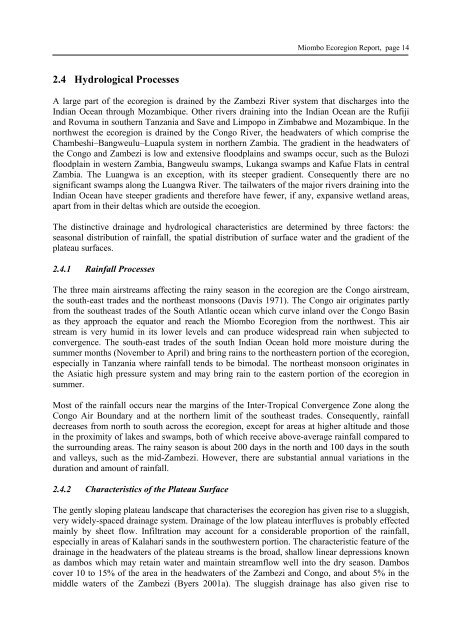Miombo Ecoregion Vision Report - Biodiversity Foundation for Africa
Miombo Ecoregion Vision Report - Biodiversity Foundation for Africa
Miombo Ecoregion Vision Report - Biodiversity Foundation for Africa
You also want an ePaper? Increase the reach of your titles
YUMPU automatically turns print PDFs into web optimized ePapers that Google loves.
2.4 Hydrological Processes<br />
<strong>Miombo</strong> <strong>Ecoregion</strong> <strong>Report</strong>, page 14<br />
A large part of the ecoregion is drained by the Zambezi River system that discharges into the<br />
Indian Ocean through Mozambique. Other rivers draining into the Indian Ocean are the Rufiji<br />
and Rovuma in southern Tanzania and Save and Limpopo in Zimbabwe and Mozambique. In the<br />
northwest the ecoregion is drained by the Congo River, the headwaters of which comprise the<br />
Chambeshi–Bangweulu–Luapula system in northern Zambia. The gradient in the headwaters of<br />
the Congo and Zambezi is low and extensive floodplains and swamps occur, such as the Bulozi<br />
floodplain in western Zambia, Bangweulu swamps, Lukanga swamps and Kafue Flats in central<br />
Zambia. The Luangwa is an exception, with its steeper gradient. Consequently there are no<br />
significant swamps along the Luangwa River. The tailwaters of the major rivers draining into the<br />
Indian Ocean have steeper gradients and there<strong>for</strong>e have fewer, if any, expansive wetland areas,<br />
apart from in their deltas which are outside the ecoegion.<br />
The distinctive drainage and hydrological characteristics are determined by three factors: the<br />
seasonal distribution of rainfall, the spatial distribution of surface water and the gradient of the<br />
plateau surfaces.<br />
2.4.1 Rainfall Processes<br />
The three main airstreams affecting the rainy season in the ecoregion are the Congo airstream,<br />
the south-east trades and the northeast monsoons (Davis 1971). The Congo air originates partly<br />
from the southeast trades of the South Atlantic ocean which curve inland over the Congo Basin<br />
as they approach the equator and reach the <strong>Miombo</strong> <strong>Ecoregion</strong> from the northwest. This air<br />
stream is very humid in its lower levels and can produce widespread rain when subjected to<br />
convergence. The south-east trades of the south Indian Ocean hold more moisture during the<br />
summer months (November to April) and bring rains to the northeastern portion of the ecoregion,<br />
especially in Tanzania where rainfall tends to be bimodal. The northeast monsoon originates in<br />
the Asiatic high pressure system and may bring rain to the eastern portion of the ecoregion in<br />
summer.<br />
Most of the rainfall occurs near the margins of the Inter-Tropical Convergence Zone along the<br />
Congo Air Boundary and at the northern limit of the southeast trades. Consequently, rainfall<br />
decreases from north to south across the ecoregion, except <strong>for</strong> areas at higher altitude and those<br />
in the proximity of lakes and swamps, both of which receive above-average rainfall compared to<br />
the surrounding areas. The rainy season is about 200 days in the north and 100 days in the south<br />
and valleys, such as the mid-Zambezi. However, there are substantial annual variations in the<br />
duration and amount of rainfall.<br />
2.4.2 Characteristics of the Plateau Surface<br />
The gently sloping plateau landscape that characterises the ecoregion has given rise to a sluggish,<br />
very widely-spaced drainage system. Drainage of the low plateau interfluves is probably effected<br />
mainly by sheet flow. Infiltration may account <strong>for</strong> a considerable proportion of the rainfall,<br />
especially in areas of Kalahari sands in the southwestern portion. The characteristic feature of the<br />
drainage in the headwaters of the plateau streams is the broad, shallow linear depressions known<br />
as dambos which may retain water and maintain streamflow well into the dry season. Dambos<br />
cover 10 to 15% of the area in the headwaters of the Zambezi and Congo, and about 5% in the<br />
middle waters of the Zambezi (Byers 2001a). The sluggish drainage has also given rise to


